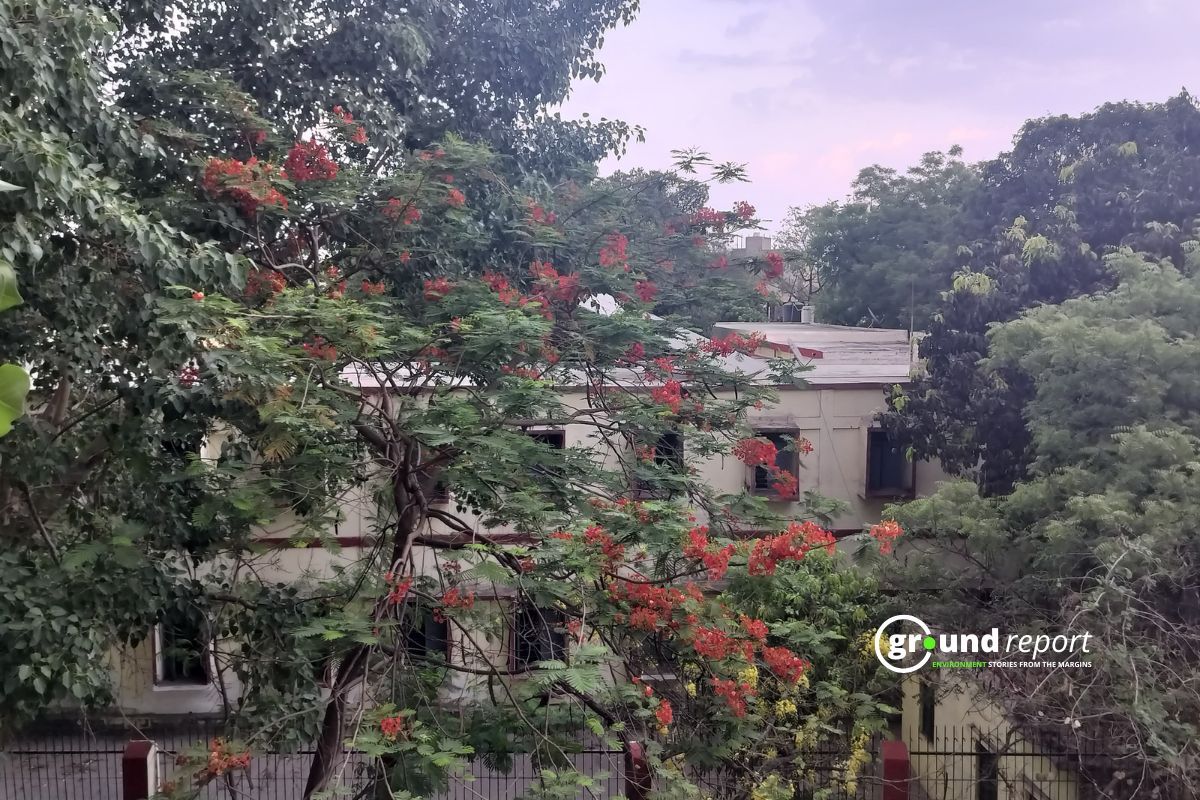Located 140.8 kilometres from Bhopal, Rajgarh stands as one of India’s most economically challenged districts. Recognizing its potential, NITI Aayog has designated it an ‘aspirational district’, promising transformative development. Ambitious infrastructure projects—including large dams, railway lines, colleges, polytechnics, and national highways—aim to connect Rajgarh with major cities like Bhopal and Indore.
However, this progress comes at a massive environmental cost. With no dense forests to begin with, Rajgarh is witnessing massive deforestation. More than 800 trees have already been felled for just two road projects. When accounting for both legal and illegal tree cutting, the actual number could be significantly higher.

Experts fear that the loss of green cover could trigger a surge in temperatures and increase the risk of heat-related health problems. The region now experiences intense heat not just during the day, but through the night, bringing oppressive hot winds that compound the environmental challenges.
State of Forest Report
According to the India State of Forest Report 2023, there is no single dense forest area in Rajgarh. The maximum amount of open forest is in Rajgarh, which covers an area of 135 sq km. Rajgarh has moderately dense forests in an area of 35 square kilometres and bushes in an area of 32 square kilometres.
At the same time, if the presence of forests is seen in the municipal area of Rajgarh, then only 0.92 square kilometres of forests are present here. This small amount of open forest is present only in the Rajgarh Municipality area.
Comparing the current forest report with the 2021 data reveals a stark decline in Rajgarh’s forest cover. In just two years, the district has lost 1.20 square kilometres of forest area—a significant reduction for an already forest-depleted region.
Trees felled in Rajgarh
Rajgarh’s Divisional Forest Officer (DFO) Veni Prasad Dotania says that the district, which spans an area of 6,154 square kilometres, is losing its forest area at an alarming rate. “The district, which already has very little forest area, and the way trees are being felled for development projects, sets a very dangerous trend,” he points out.

Dotania expresses concerns about how the state government has increased the powers of the gram sabha to simplify the felling of trees from January 1, 2023. This has resulted in the forest department not having the actual data of the trees to be cut for development works under the revenue land.
In the years 2022 and 2023, a total of 11 cases have been registered in the case of illegally cutting 178 trees by the Forest Department. Out of these, 7 cases are from the year 2022, in which 143 trees have been affected. Four cases are from 2023, in which 35 trees have been affected.
Dotania identifies developmental projects as a primary driver of Rajgarh’s forest cover decline. A prime example is the ongoing Ramganj Mandi to Bhopal railway line project, which began in 2022. As farmers’ lands are acquired within the revenue area, trees on private properties have been systematically felled during the acquisition process.
Critically, the forest department’s inability to track the number of trees cut for the railway project reveals a troubling lack of transparency in environmental impact assessments for developmental initiatives.

According to the Forest Department of Rajgarh, another major development project contributing to extensive deforestation is the Suthalia Major Irrigation Project. Launched in 2022, the project falls within the revenue boundaries of the Rajgarh district. Officials have stated that it is difficult to track the number of trees felled since the project is located within these boundaries. Additionally, land owned by villagers within the project area has been acquired, and the trees previously planted on it have been cut down. Work on the project is still ongoing.
However, Gajendra Singh Sisodia, SDO of the Suthalia Major Irrigation Project, refuted such claims. He shares that the project has maintained its environmental considerations. “We have submitted the environmental report and received clearance,” he said.
“Since the project does not affect forest land and is within revenue limits, our dam line work is progressing through farmers’ fields,” he adds. However, according to the Forest Department, Rajgarh, in the year 2022, on the private revenue land of Rajgarh district, trees have been cut by the farmers after the order of the Gram Sabha.
Similarly, National Highway No. 752C, constructed in the same year, was also built within the revenue area of Rajgarh district, resulting in the felling of 317 trees. Additionally, 570 trees were removed for the construction of the Khujner bypass road.

According to available data, a total of 897 trees have been lost due to various development projects in the region. However, this figure may not account for all instances of tree felling, and the actual number could be significantly higher.
In the last few years, like different parts of the country, Rajgarh has also seen an unexpected rise in temperature. Dotania connects the dots between tree felling and temperature rise in the region.
Trees withered; heat rises
In 2024, Rajgarh became one of the hottest districts in Madhya Pradesh, with temperatures soaring to 45 degrees Celsius. The heat is unrelenting, with hot winds continuing not just during the day but throughout the night. As a result, the state government has classified the district as one of the most vulnerable to environmental changes.
Research reveals a stark connection between deforestation and rising temperatures. In tropical regions, tree loss has increased daily high temperatures by an average of 4.4°C. India has experienced a significant reduction in forest cover, losing 668,400 hectares over the past 30 years, which has directly contributed to local temperature increases and heightened risks of heat-related health issues.
An increase in summer temperatures due to deforestation increases heat stress, increasing the risk of heat-related diseases in the population. Heat-related health problems in India include an increase in the number of hospitalizations for cardiovascular diseases and mental health problems. Deforestation contributes to climate change by releasing stored carbon, which leads to rising temperatures and changes in weather patterns that directly affect human health.
Dr Sudhir Kalawat, MD, Rajgarh District Hospital, while talking to the ground report, said, “Normally, the body temperature of a human being is 37 degrees Celsius. When the temperature rises above this, the body starts to heat up, which we call fever in common parlance. As the temperature increases, the blood vessels dilate and the blood pressure decreases. When the heatwave goes on, we see how many patients are suffering from vomiting and dizziness. Because when the temperature increases, then it has a direct effect on the heart, there is dizziness and fainting.

Understanding the effect of increased temperature on diabetics, Dr. Kalawat says,
People with diabetes who take insulin have a lower or higher absorption of insulin. As the temperature of the body increases, it also affects the kidneys, liver, heart and stomach. At the same time, the elderly are at risk of death.
According to the Environment Ministry’s report, Rajgarh district faces compounding environmental challenges: poor soil quality, limited rainfall, and increasingly rugged terrain. The ongoing destruction of the district’s remaining trees for development projects raises a critical question: What value is progress if it renders the city itself uninhabitable?
Support us to keep independent environmental journalism alive in India.
Keep Reading
How much budget BJP govt in Delhi allocate for environmental causes?
Temperature crosses 40°C in seven cities of Madhya Pradesh
Deadly wildfires ravage South Korea, killing at least 24
SC fines ₹1 lakh per tree for illegal felling in Mathura-Vrindavan
Follow Ground Report on X, Instagram and Facebook for environmental and underreported stories from the margins. Give us feedback on our email id greport2018@gmail.com.
Don’t forget to Subscribe to our weekly newsletter, Join our community on WhatsApp, and Follow our YouTube Channel







